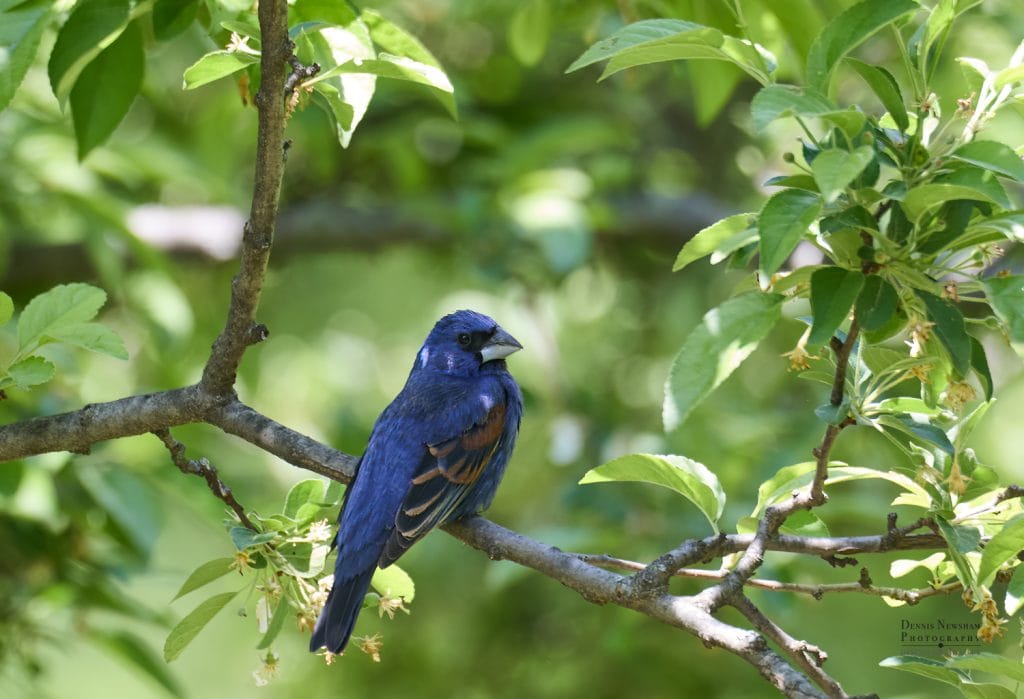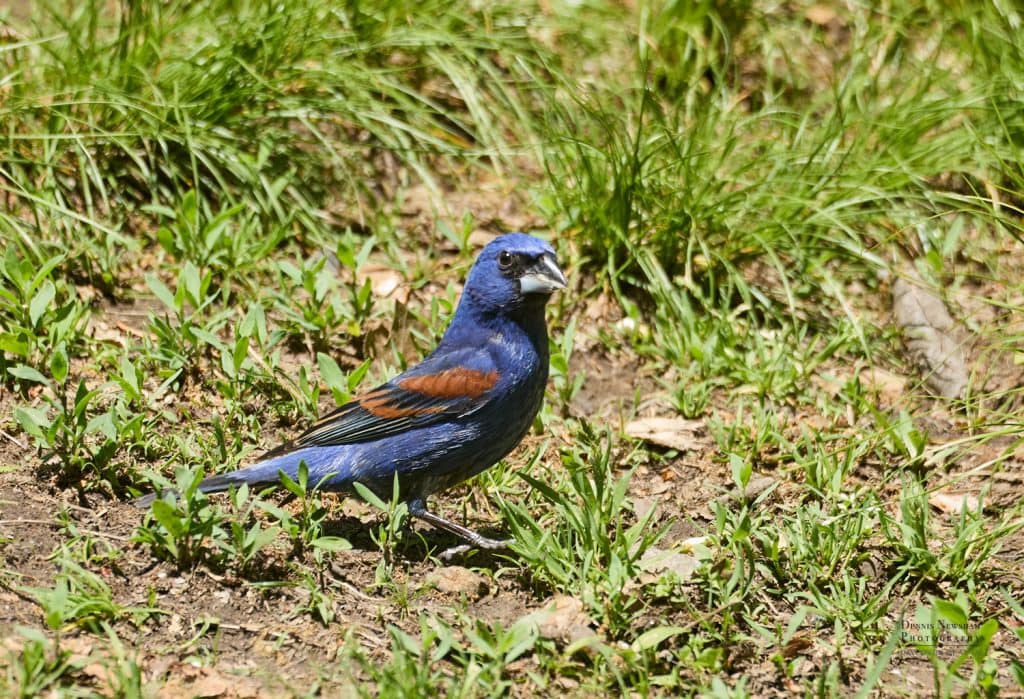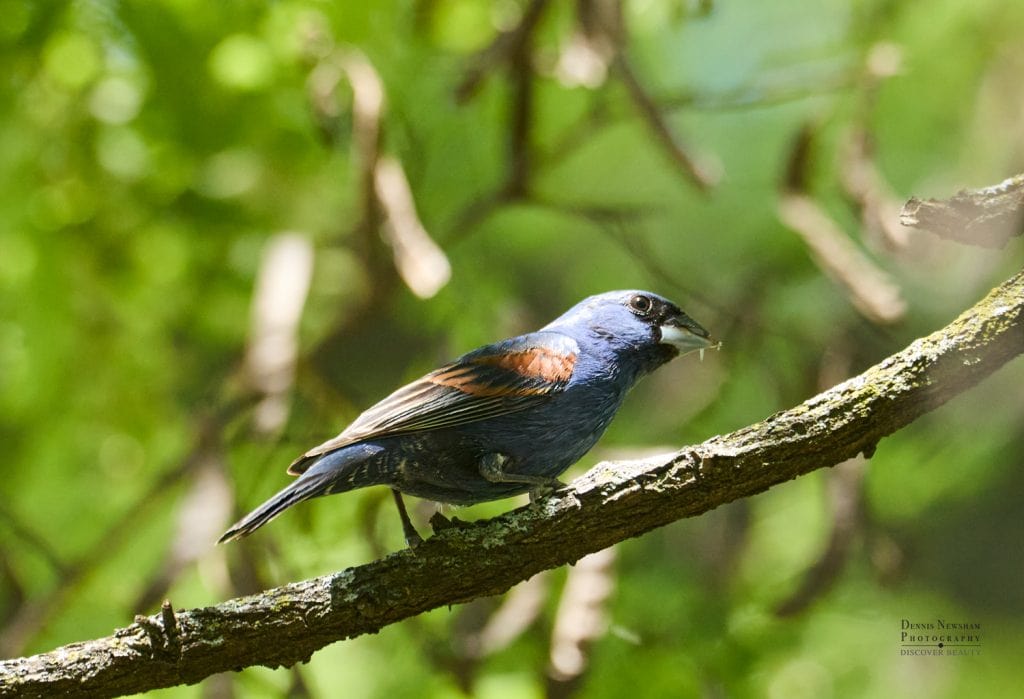
A Quiet Start in a City Full of Noise
There’s something magical about spring migration in New York City. It’s unpredictable, full of potential, and a time when even the most familiar parks can reveal unexpected treasures. You go out with your camera, maybe your binoculars, and a head full of hope—never knowing what you might find. On a recent outing, I had an unforgettable encounter with a Blue Grosbeak in Central Park, a reminder of just how exciting birding during migration can be.
Recently, I spent a day birding in Central Park. The weather was beautiful: bright skies, mild air, and the buzz of fellow birders scattered through the Ramble. But even with perfect weather, there’s no guarantee. Birds move on their own schedule. Hours passed with only a handful of sightings, and I found myself quietly settling into one of my favorite spots—Tanner Spring.
The Stillness of Tanner Spring
Tanner Spring is a little pocket of wild tucked into the park. It’s shadowy and secluded, yet only steps away from Central Park West. The trees provide a canopy of green, and even though you can still hear the sounds of the city—horns, footsteps, snippets of conversation—it feels like another world. There’s water, dense underbrush, and just enough quiet to make you forget where you are.
Birding here is about more than just looking. It’s about listening, anticipating, and hoping. The rustle of a leaf, the whisper of wings, a faint chip note in the distance—it all sharpens your senses. Sometimes you sit there for long stretches, just watching the water and waiting. You share soft conversations with other birders: what’s been seen that day, what might still be around. That’s one way the birding community builds itself—through shared silence, small talk, and the occasional excited whisper.
I was just starting to consider heading home when a fellow birder received an alert. A Blue Grosbeak had been spotted not far from us. I’ve seen them before—this wasn’t a life bird—but they’re still uncommon enough in Central Park to make the heart race. I hadn’t been checking my phone; I was too caught up in the moment. But luckily, she turned to me and said, “Let’s go. It’s not far.” That one simple invitation changed the whole day.
An Uncommon Visitor Appears
We made our way through the park, adrenaline replacing fatigue. The closer we got, the more my mind shifted from disappointment to anticipation. And then we arrived. A few birders stood near a rock just off a chipped path. “Are you looking for the Blue Grosbeak?” someone asked. “It’s right here.” I looked up, and there he was.
A male Blue Grosbeak in full breeding plumage. Deep, velvety blue with warm chestnut wing bars. The bird was perched on a rock that held a small puddle in its center. From beneath the rock, termites were emerging in a slow, shimmering hatch. The grosbeak was taking full advantage—feeding on the termites, hopping down to the ground, and occasionally flying into nearby trees. His movements were calm and deliberate, giving everyone a chance to appreciate the show.

Species Snapshot: The Blue Grosbeak
The Blue Grosbeak is a stocky songbird in the cardinal family, Cardinalidae. Its large, triangular bill gives it a powerful look, well-suited for cracking seeds and foraging insects. While they breed in the southern U.S. and northern Mexico, they migrate northward in spring and sometimes pass through the city.
- Plumage: Males are a striking deep blue with two rust-colored wing bars; females are warm brown with subtle markings.
- Diet: Though largely insectivorous—feeding on insects, snails, and spiders—Blue Grosbeaks also eat seeds, berries, and buds from trees like maples. They’re especially fond of sunflower seeds.
- Population Status: Partners in Flight estimates their global breeding population at 35 million and rates them 8 out of 20 on the Continental Concern Score, classifying them as a species of low conservation concern.

The Patience and Precision of Photography
Photographing the bird was both thrilling and challenging. The midday sun was high and harsh, casting deep shadows and strong highlights. Blue is a tricky color for camera sensors—it can easily lose detail or appear overexposed. I had to constantly adjust my settings: changing aperture, tweaking shutter speed, compensating for shifting light as the bird moved between rock and tree.
One second it was backlit; the next, dappled in shade. And all the while, I tried to move slowly and fluidly avoiding sudden motions that might spook him. My heart raced as I checked the back of the camera. I whispered to myself, “I got him.” But I didn’t stop. I kept shooting, hoping to capture more of the bird’s behavior—how he fed, how he paused, how his back glowed electric blue when he lifted into flight.
Birding as Practice in Presence
Sometimes birding is just that: waiting, hoping, watching. Looking around every corner, peering into shadows, listening for the softest flutter. It teaches you patience. It hones your senses. It reminds you to be still.
Migration birding, especially, sharpens everything. You notice the light, the wind, the changes in temperature. You scan constantly. You listen to subtle shifts in tone. Not all birds come to you—you must go to them. And even when you’re sure nothing’s happening, one moment can change it all.
Each corner of Central Park offers a different experience. Tanner Spring is intimate and shaded. The Ramble is unpredictable and alive. The Pool, the North Woods, Sparrow Rock—each one has its own light, its own energy, and its own seasonal rhythm. Birding here is like walking through a series of mini ecosystems.
That day, the rock with the puddle was exposed to full sun. The termites brought the grosbeak in, and his movements between open space and the nearby trees made him wonderfully visible. But I wouldn’t have known about any of it without that one birder who turned and said, “Let’s go.” That’s the beauty of this community—it’s built on curiosity, generosity, and shared wonder.
Sharing the Moment, Sharing the Wonder
Spring migration in New York feels like a kind of rebirth. It brings waves of birds into the city—some here for just a day or two, some staying to breed. In a place known for its hustle, migration forces you to slow down. To look up. To notice.
And sometimes, the most extraordinary moments happen while joggers and dog walkers pass by, unaware. They don’t know that something rare is just a few feet away. That’s why I always try to look—not just forward, but up, around, and behind. You never know what’s waiting to be seen.
If this Blue Grosbeak encounter made you pause, I invite you to explore more of these fleeting moments through my photography. Many of the birds I’ve captured in Central Park—including the grosbeak—are featured on prints, puzzles, note cards, and textiles available in my shop. It’s my way of helping others bring a little of New York’s wild beauty into their homes.
Below are some of my favorite images from that unforgettable day—some I’ve shared already, and a few making their first appearance here. I hope they bring you the same sense of wonder I felt in the moment..
Click here to read our Privacy Policy